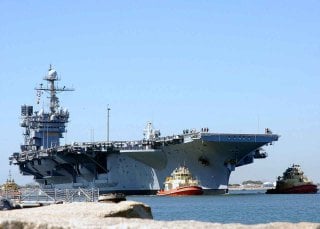The USS John F. Kennedy Meets an Ignominious End
Instead of preservation as a museum ship—which might allow certain foreign visitors to learn too much about existing aircraft carriers—the USS John F. Kennedy is being sent to the scrap heap.
Old soldiers (and old sailors for that matter) may fade away, but modern warships meet a crueler fate: they head to the scrap yard and are "broken up" after their years of service. It begins with a final transit this week.
Such will be the case with the ex-John F. Kennedy (CV-67) in the coming months. The retired Kitty Hawk variant supercarrier was scheduled to depart the United States Navy's Inactive Ships Maintenance Facility in Philadelphia on Wednesday but the departure was delayed to Thursday. It will be towed to Brownsville, Texas, Naval Sea Systems announced.
The transit will take around two weeks.
In 2022, the retired U.S. Navy aircraft carriers USS Kitty Hawk (CV-63) and USS John F. Kennedy were sold to International Shipbreaking Limited in Texas for just one cent each. The two final conventionally powered carriers were launched in the 1960s and retired in 2009 and 2007 respectively. Though there had been efforts to see the carriers maintained as floating museums, the donation status was subsequently revoked—and instead, the vessels will be broken apart in a process that could around 18 months each.
About CV-67
USS John F. Kennedy had the distinction of being the final conventionally powered aircraft built for the United States Navy. She was the first carrier to be named for the late president, who was assassinated in Dallas, Texas, on November 22, 1963.
Commissioned in September 1968, the warship "conducted 18 deployments including to the Mediterranean, Tyrrhenian, Ionian, Ligurian, Aegean and Adriatic seas, during a period of escalating tension in the Middle East and North Africa, often while under the surveillance of Soviet ships," Naval Sea Systems added.
CV-67 was among the warships deployed to the mid-Atlantic seaboard in response to the 9/11 terrorist attacks on New York City's World Trade Center and the Pentagon, before being deployed to support Operations Anaconda and Enduring Freedom, followed by support of Operation Iraqi Freedom.
End of the Line for CV-67
After USS Kitty Hawk was retired in 2009, a veterans' association raised $5 million to see the warship preserved as a floating museum. However, the U.S. Navy deep-sixed the plan, and both CV-63 and CV-67 were ordered to be scrapped.
What is noteworthy is that the USS Saratoga Museum Foundation had sought for years to have the Forrestal-class carrier preserved, but the U.S. Navy took that retired carrier off its donation status list and at one point reportedly offered USS John F. Kennedy instead.
So why did the service change course again?
Though the U.S. Navy only said that it would expect the carriers to be maintained after being decommissioned, there has been speculation that the carrier's design and layout could reveal secrets and details about the Nimitz and Ford class. In other words, the Pentagon didn't want "tourists" (especially those from China and Russia) gathering any secrets by strolling through the retired vessels.
That fact may also explain why calls to sell—or even give—the retired USS Kitty Hawk or USS John F. Kennedy to India. Instead, the carriers were officially sold for a penny. And we say "officially" because the U.S. military doesn't give things away for free, and it should be added the Navy also had to pay the Texas-based shipbreaker $3 million for the towing!
Thursday will offer a chance for carrier enthusiasts to see CV-67 begin her final transit.
"Upon departure early on Wednesday morning, the ship will be visible from the waterfronts along the Delaware River as the ship transits through the Delaware Bay and into the North Atlantic Ocean," Naval Sea Systems stated.
Finally, while this does mark the end of the line for CV-67, later this year the next USS John F. Kennedy (CVN-79) will join the fleet as the second Gerald R. Ford-class nuclear-powered supercarrier.
Peter Suciu is a Michigan-based writer. He has contributed to more than four dozen magazines, newspapers, and websites with over 3,200 published pieces over a twenty-year career in journalism. He regularly writes about military hardware, firearms history, cybersecurity, politics, and international affairs. Peter is also a Contributing Writer for Forbes and Clearance Jobs. You can follow him on Twitter: @PeterSuciu. You can email the author: [email protected].
Image: Wikimedia Commons.

